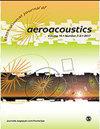Aeroacoustic noise prediction of a vertical axis wind turbine using large eddy simulation
IF 1.3
4区 工程技术
Q3 ACOUSTICS
引用次数: 1
Abstract
This study investigates the numerical prediction for the aerodynamic noise of the vertical axis wind turbine using large eddy simulation and the acoustic analogy. Low noise designs are required especially in residential areas, and sound level generated by the wind turbine is therefore important to estimate. In this paper, the incompressible flow field around the 12 kW straight-bladed vertical axis wind turbine with the rotor diameter of 6.5 m is solved, and the sound propagation is calculated based on the Ffowcs Williams and Hawkings acoustic analogy. The sound pressure for the turbine operating at high tip speed ratio is predicted, and it is validated by comparing with measurement. The measured spectra of the sound pressure observed at several azimuth angles show the broadband characteristics, and the prediction is able to reproduce the shape of these spectra. While previous works studying small-scaled vertical axis wind turbines found that the thickness noise is the dominant sound source, the loading noise can be considered to be a main contribution to the total sound for this turbine. The simulation also indicates that the received noise level is higher when the blade moves in the downwind than in the upwind side.基于大涡模拟的垂直轴风力发电机气动噪声预测
采用大涡模拟和声学类比的方法对垂直轴风力机气动噪声进行了数值预测。低噪音设计是必需的,特别是在居民区,因此风力涡轮机产生的声级是重要的估计。本文求解了转子直径为6.5 m的12kw直叶垂直轴风力机的不可压缩流场,并基于Ffowcs Williams和Hawkings声学类比计算了声音的传播。对涡轮在高叶尖速比工况下的声压进行了预测,并与实测结果进行了对比验证。在多个方位角观测到的实测声压谱显示出宽带特性,预测能够再现这些谱的形状。虽然以往对小型垂直轴风力机的研究发现厚度噪声是主要声源,但载荷噪声可以认为是该风力机总声的主要贡献。仿真还表明,叶片在顺风方向运动时,接收到的噪声水平比在顺风方向运动时高。
本文章由计算机程序翻译,如有差异,请以英文原文为准。
求助全文
约1分钟内获得全文
求助全文
来源期刊

International Journal of Aeroacoustics
ACOUSTICS-ENGINEERING, AEROSPACE
CiteScore
2.10
自引率
10.00%
发文量
38
审稿时长
>12 weeks
期刊介绍:
International Journal of Aeroacoustics is a peer-reviewed journal publishing developments in all areas of fundamental and applied aeroacoustics. Fundamental topics include advances in understanding aeroacoustics phenomena; applied topics include all aspects of civil and military aircraft, automobile and high speed train aeroacoustics, and the impact of acoustics on structures. As well as original contributions, state of the art reviews and surveys will be published.
Subtopics include, among others, jet mixing noise; screech tones; broadband shock associated noise and methods for suppression; the near-ground acoustic environment of Short Take-Off and Vertical Landing (STOVL) aircraft; weapons bay aeroacoustics, cavity acoustics, closed-loop feedback control of aeroacoustic phenomena; computational aeroacoustics including high fidelity numerical simulations, and analytical acoustics.
 求助内容:
求助内容: 应助结果提醒方式:
应助结果提醒方式:


